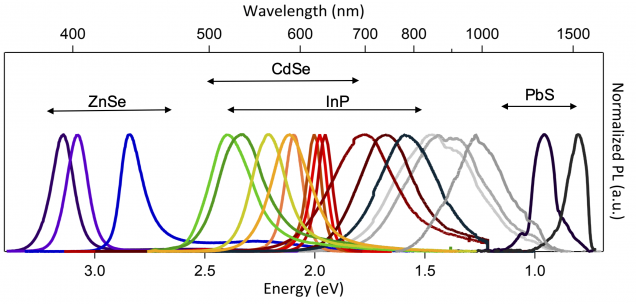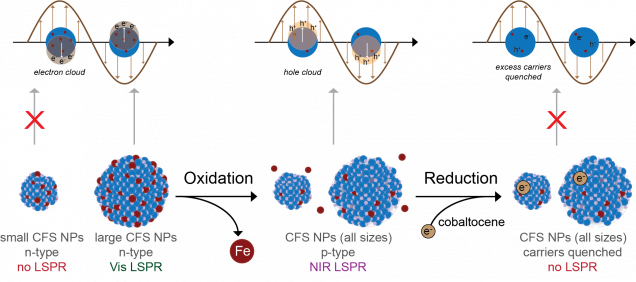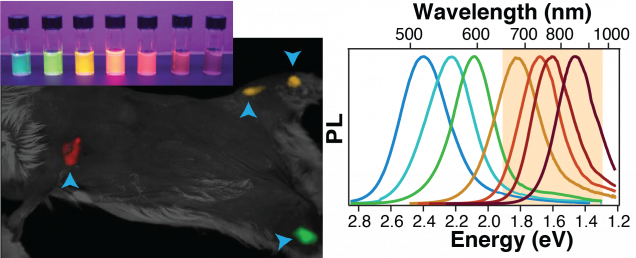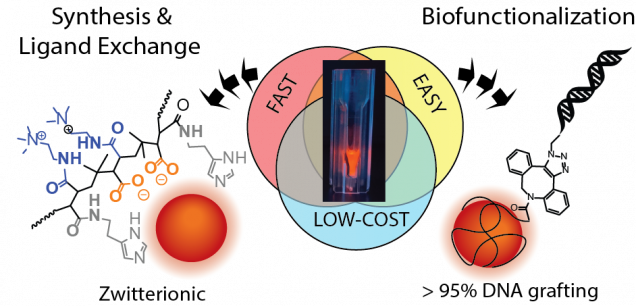As of July 2022, Prof. Dennis joined the Chemical Engineering Department at Northeastern University. This site is no longer maintained, but you can check out our more recent activity at thedennislab.com.
Research
The Dennis Lab uses the concerted design of semiconductor quantum dots (QDs) for sensing and imaging applications.
We use our own QDs and other fluorophores spanning broad wavelength ranges for use in Förster resonance energy transfer (FRET)-based sensing, visual color change-based sensing, and preclinical imaging.
Nanotoxicity and degradation considerations are forefront for considering how we could better design QDs for eventual clinical translation as optical contrast agents for human diagnostic imaging.
We are committed to devising and sharing accessible protocols for coating and biofunctionalizing QDs to promote dissemination of the materials for applications led by a diverse set of research groups.
QD Core Engineering and Photophysical Characterization
(Plasmonic and Photoluminescent Semiconductor Nanoparticles)
Correlating ZnSe Quantum Dot Absorption with Particle Size and Concentration. Chemistry of Materials, 2021, 33, 18, 7527–7536.
Controlled synthesis and exploration of CuxFeS4 bornite nanocrystals. Chemistry of Materials, 2021, 33, 18, 7408–7416.
Quantum Dot Synthesis– Core/Shell Heterostructure Engineering
Engineering Brightness-Matched Indium Phosphide Quantum Dots. Chemistry of Materials, 2021, 33(6):1964–1975.
Bandgap Engineering of InP Heterostructured Quantum Dots: Tailoring Emission with Shell Composition and Thickness. Frontiers in Chemistry, 2018, 6:587.
Extending the Near-Infrared Emission Range of Indium Phosphide Quantum Dots for Multiplexed In Vivo Imaging. Nano Letters, 2021, 21(7):3271–3279.
QD Heterostructures and Förster Resonance Energy Transfer (FRET)
Quantum Dot to Quantum Dot Förster Resonance Energy Transfer: Engineering Materials for Visual Color Change Sensing. Analyst, 2020, 145 (17):5754 – 5767.
Quantifying Shell Thickness Effects on Quantum Dot Brightness and Energy Transfer. Nanoscale, 2017, 9(42):16446-16458.
Small Molecule Biosensing using Allosteric Transcription Factor-DNA Binding
Transcription Factor Based Small Molecule Sensing with a Rapid Cell Phone Enabled Fluorescent Bead Assay. Angewandte Chemie International Edition, 2020, 59(48):21597-21602. PDF
A Förster Resonance Energy Transfer-Based Ratiometric Sensor with the Allosteric Transcription Factor TetR. Small, 2020, 1907522.
A Novel Progesterone Biosensor Derived from Microbial Screening. Nature Communications, 2020, 11: 1276.
Surface Immobilized Nucleic Acid – Transcription Factor Quantum Dots for Biosensing. Advanced Healthcare Materials, 2020, 2000403.
Nanoparticle Degradation and Nanotoxicity
Shell-Free Copper Indium Sulfide Quantum Dots Induce Toxicity in Vitro and in Vivo. Nano Letters, 2020, 20(3):1980-1991.
Ligands and media impact interactions between engineered nanomaterials and clay minerals. NanoImpact, 2019, 13:112-122.
Quantifying Engineered Nanomaterial Toxicity: Comparison of Common Cytotoxicity and Gene Expression Measurements. Journal of Nanobiotechnology, 2017, 15(1):79.
QD Coatings and Biofunctionalization
A versatile and accessible polymer coating for functionalizable zwitterionic quantum dots with high DNA grafting efficiency. Chemical Communications, 2019, 55:11067-11070.
Phase transfer and DNA functionalization of quantum dots using and easy to prepare, low-cost zwitterionic polymer. In Fontes A and BS Santos (Eds.), Quantum Dots. Methods in Molecular Biology, Vol. 2135. Humana, New York, NY.
Encapsulating Quantum Dots in Lipid-PEG Micelles and Subsequent Copper-Free Click Chemistry Bioconjugation. In Fontes A and BS Santos (Eds.), Quantum Dots. Methods in Molecular Biology, Vol. 2135. Humana, New York, NY.
Collaborative Applications of QDs
Tunable beamed light emission from a quantum-dot ensemble near a gradient metasurface. Advanced Optical Materials, 2020, 1901951.
Measuring Nanoparticle Polarizability using Fluorescence Microscopy. Nano Letters, 2019, 19(8):5762-5768.
Reviews and Perspective Articles
In Vivo Biosensing using Resonance Energy Transfer. Biosensors, 2019, 9(2):76.
Sensing with Photoluminescent Semiconductor Quantum Dots. Methods and Applications in Fluorescence, 2019, 7: 012005.
Emerging Physicochemical Phenomena along with New Opportunities at the Biomolecular–Nanoparticle Interface. Journal of Physical Chemistry Letters, 2016, 7(11):2139-2150.
Förster Resonance Energy Transfer between Quantum Dot Donors and Quantum Dot Acceptors. Sensors, 2015, 13(6):13288-13325.








